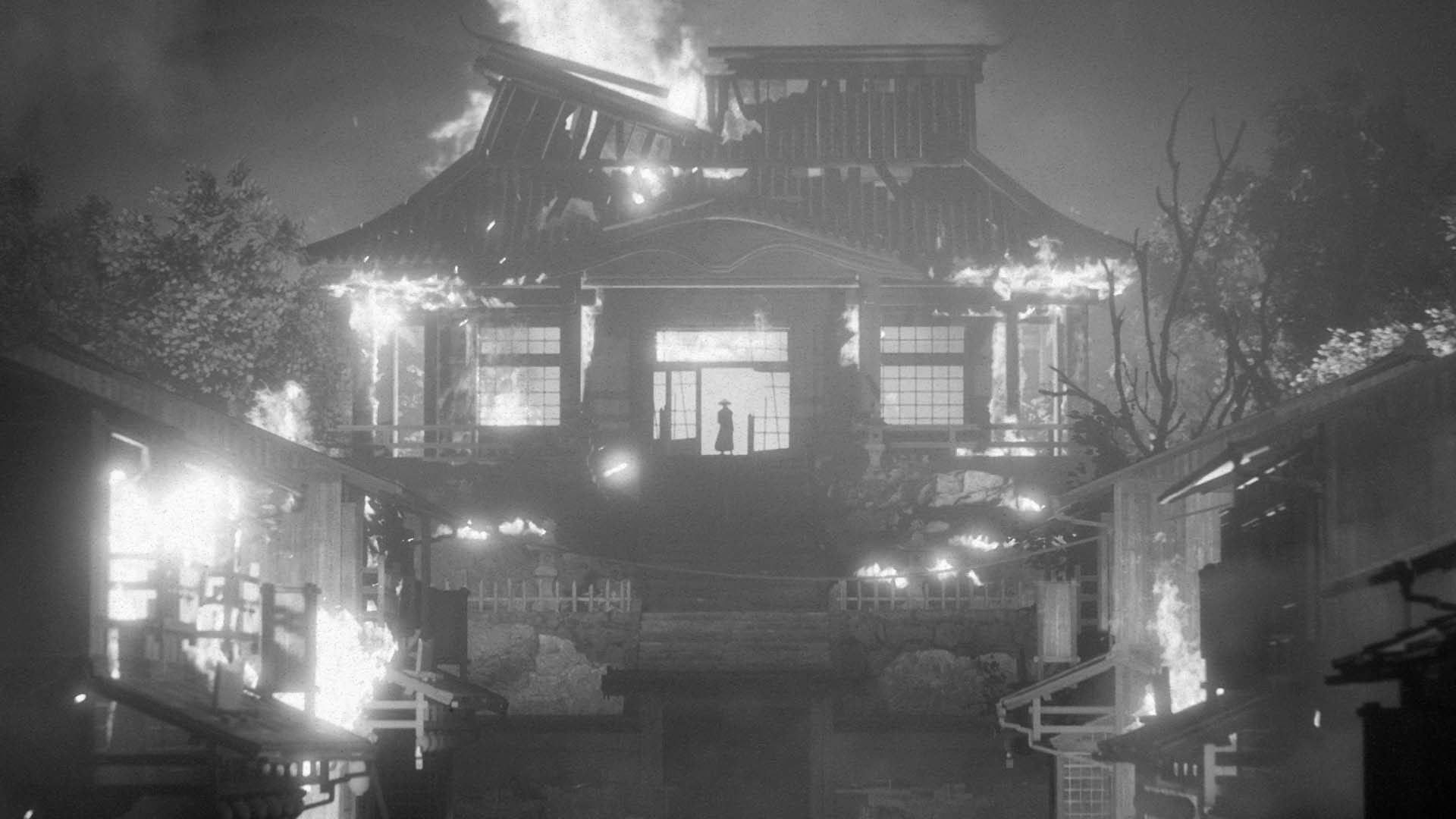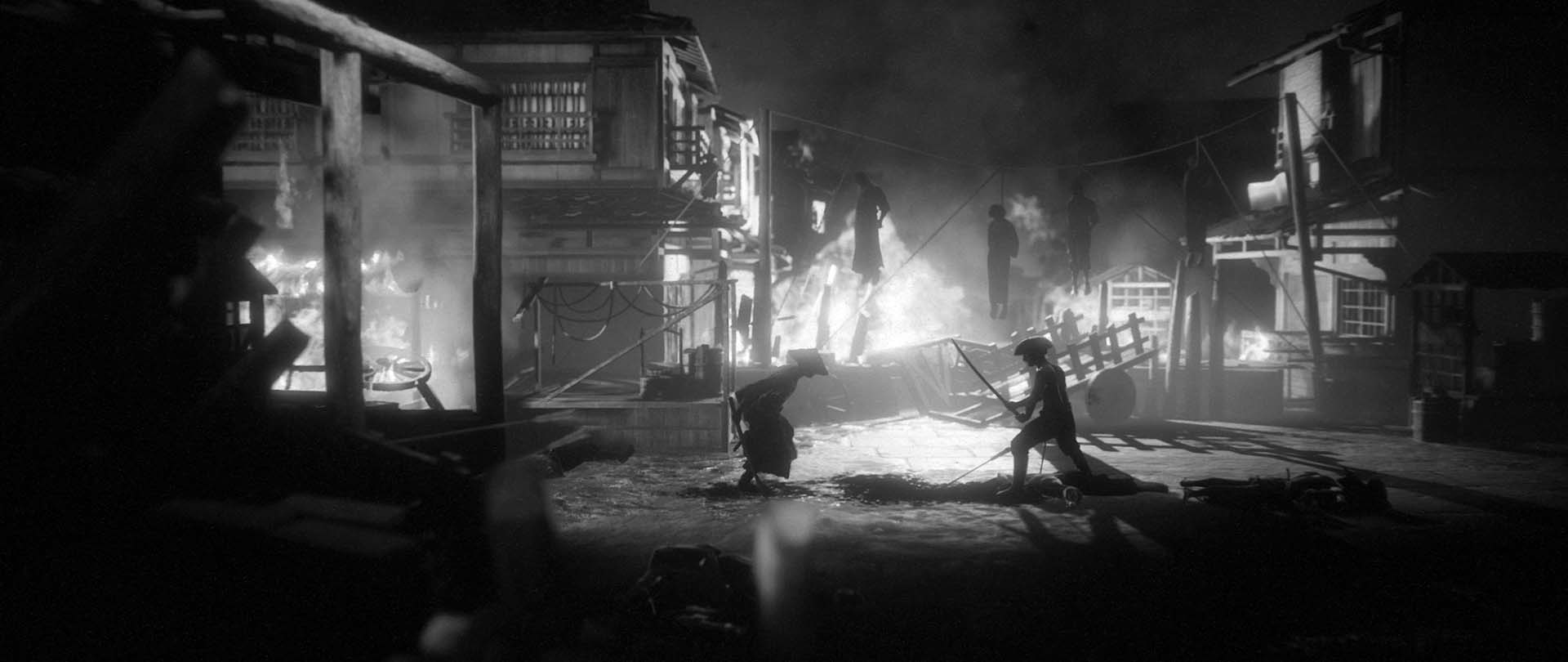Trek to Yomi, the latest from iconoclastically branded publisher Devolver Digital, is the epitome of style over substance. It’s a beautiful game, crammed full of detailed backgrounds, dynamic camera angles, and lighting that understands how to make the most out of a black-and-white color scheme. I’m not a huge nerd about classic samurai cinema, but as far as my novice eye is concerned, developer Flying Wild Hog certainly nailed what those films look like—at least more so than the last big samurai game that claimed to take its inspiration from the works of Kurosawa. But the visuals feel like a veneer, covering up its narrative and gameplay imperfections.
Taking place during some indeterminate time in ancient Japanese history, Trek to Yomi’s story centers on a swordsman, Hiroki, whose village is attacked by a bandit warlord and the fallout from that event. As the story unfolds, Hiroki literally has to go to hell and back to find the strength required to defeat his enemies and confront his own shortcomings as a samurai. It’s the kind of paper-thin and occasionally compelling story that benefits from a more cinematic presentation.
One of Trek to Yomi’s neatest tricks is how it makes itself appear cinematic when, really, it’s just another 2D side-scrolling action game—and that’s by cleverly delineating how it uses its camera. During combat, Yomi adopts a standard side-scrolling perspective, and you can only move Hiroki from left to right. Between combat situations, Hiroki explores the world with fixed camera angles that feel like they’re ripped straight from the original Resident Evil games, although not as claustrophobic. Finally, there are the more standard cutscenes that give the story the chance to lean into close-ups, even if none of the characters really tap into the kabuki traditions that inspired a lot of samurai film actors in the 1950s and ’60s.
What makes Trek to Yomi so visually striking is how its various camera angles give you the sense that you’re looking at a living diorama. At times, with some foregrounded detritus and tilt-shift lenses, the game looks more like an homage to Wes Anderson’s stop-motion animations than it does Seven Samurai—or at least a hybrid of the two—and that’s not a bad thing. It’s also a smart way for the developers to hide moments where the visuals might not hold up to close scrutiny, particularly with the animation. Even still, it’s truly impossible to overstate how visually striking Trek to Yomi is.

Unfortunately, the excellent visuals and art design can’t fully distract from Trek to Yomi’s stilted and boring gameplay. Combat is easy to learn and even easier to master: There’s a light attack, a heavy attack, a block, a parry, a roll, a few combos, and some ranged options. There’s not much reason to learn a bunch of different combos, however, as there are only a few that are effective, and you will most likely just spam the parry button and counterattack most of the time. It feels like you have an entire Home Depot on your tool belt when all you really need is a hammer and some nails. It’s not unfun, but it does get old, even in the game’s limited five-hour runtime. Really, the gameplay shines once you beat the game for the first time and unlock the kensei mode, which makes it so that everyone except for a few bosses—including Hiroki—die in one hit. That’s when the samurai-film rubber meets the road and combat encounters start to look like the dusty, climactic fight at the end of Yojimbo.
What really holds Yomi’s combat back is a feeling of inconsistency. The timing on parries and counter attacks felt inconsistent, and. I was never exactly clear on how much damage I was doing to an enemy, at least on the standard difficulty. Couple these uncertainties with stilted animations that distract from the visuals, and you never quite feel like you’re standing on solid ground as far as the combat is concerned.
The other aspect of Trek to Yomi that doesn’t quite live up to the visuals is its story. Hiroki’s tale of redemption, and the choices that the game asks you to make along the way, never feel entirely earned or warranted. The entire story is based around the fact that Hiroki feels like a failure for letting the bandit warlord, Kagerou, destroy his village and kill the love of his life. But, without getting into too many spoilers, I was never sold that it was Hiroki’s fault to begin with. He was just doing what everyone in the village—including the village leader and his lover, Aiko—told him to do. Sure, there’s an element of survivor’s guilt that works in Hiroki’s story, but the game constantly asks you to make a choice between his love for Aiko and his duty to his village, when Aiko was the one who asked him to do what resulted in his village’s destruction in the first place. Thematically, Trek to Yomi feels forced, and that’s not great when the plot itself is as single-minded as it is.
One of the reasons that Devolver Digital has developed such a strong following and brand over the last few years, besides its eccentric E3 presentations and Adult Swim approach to social media, is that its games are all conceptually driven. But its best releases—Inscryption, Minit, My Friend Pedro, and Heave Ho, among many others—all build their clever and irreverent concepts upon a solid gameplay foundation. Trek to Yomi relies on the concept that a samurai game can look like a samurai movie, but the elements that should be foundational feel like secondary concerns. Still, if you’re hankering for some samurai action, it might be worth it to go on this trek with Hiroki.

|
★★★☆☆
Trek to Yomi is one of the most visually striking games to launch in a while, delivering on the promise that a samurai game can truly capture the look and feel of classic Japanese cinema. Unfortunately, good looks can only get you so far, as the gameplay and story don’t quite live up to the standards set by its art direction. But if you are in the mood for a samurai game, you could do worse than Trek to Yomi. |
Developer Flying Wild Hog and Leonard Menchiari Publisher Devolver Digital ESRB M - Mature Release Date 05.05.22 |
| Trek to Yomi is available on Xbox Series X/S, PlayStation 5, Xbox One, PlayStation 4, and PC. Primary version played was for PC. Product was provided by Devolver Digital for the benefit of this coverage. EGM reviews on a scale of one to five stars. | |

Michael Goroff has written and edited for EGM since 2017. You can follow him on Twitter @gogogoroff.